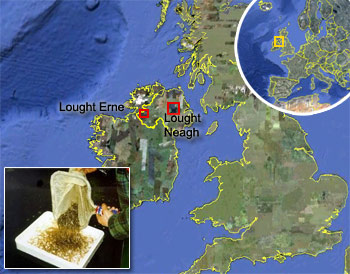
© Stock File / FISThe eel fisheries of Lough Neagh and Lough Erne are in a poor state.
There have been dire warnings about the future of Europe's largest eel fishery at Lough Neagh: numbers of elvers returning to Europe's rivers and lakes have been mysteriously dropping for years, but this season the decline has hit more fisheries than ever before.
Since 1983, Lough Neagh fishermen have been noticing the low numbers of glass eels returning from the Sargasso Sea spawning grounds.
With a view to the future, they took action, re-stocking their fishing grounds with glass eels bought from healthier fisheries such as the Severn estuary, and that has allowed them to continue meeting their quota of adult eels.
But last season the Severn estuary was the latest fishery to be hit by plummeting glass eel returns and prices for glass eels have shot up - posing a challenge for the Lough Neagh Eel Fishermen's Cooperative as they struggle to find ways to re-stock the lough, reports the Belfast Telegraph.
The situation in Lough Erne is even worse. Numbers have fallen so low that commercial eel fishing has now been banned and will not resume when the season opens in May.
The problem is the sheer mystery that surrounds these fish - scientists are a long way from knowing how and where they reproduce, let alone what is forcing their numbers to drop so low.
It's thought they spawn in the Sargasso Sea before migrating to Europe to grow in rivers and lakes and finally returning back to the sea.
Chief Fisheries Officer Marcus McAuley says scientists have never seen them spawn in the wild.
"The Sargasso Sea is assumed to be where they spawn because it is where the largest concentration of larvae are found," he said.
"But no-one has even been able to breed eels right through their life cycles.
"They are amazing, complex animals and we don't even know where they spawn, never mind what these problems are. It could be a complex range of factors, such as change in ocean current or ocean temperatures, which are all huge things."
However, the eel fishery in Lough Neagh will be able to continue as it remains sustainable thanks to the efforts to re-stock every year, McAuley said.
Although the Severn glass eels are down in number, the Lough Neagh fishermen are now able to source them from further afield, such as catchments in France and elsewhere in southern Europe.
Despite the constraints of new European regulations, they also aid the Lough Neagh fishery as they require thriving fisheries to supply a proportion of glass eels to other fisheries where they are needed.
"The intention is that more eels will spawn and the glass eels will come back and the fishery could exploit the surplus," he said.

Reader Comments
to our Newsletter